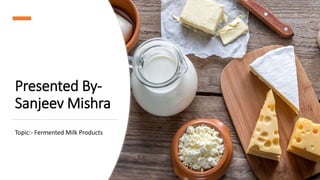
Fermented Milk Products
- 1. Presented By- Sanjeev Mishra Topic:- Fermented Milk Products
- 2. Introduction • Milk is a whitish liquid containing proteins (2.5%), lactose (5%), fats (3.6%), water (87.5%) and various minerals and vitamins (0.7%) produced by the mammary glands of all mature female mammals. • The milk produced by cows, goats and other animals is used for human consumption. • Milk is extremely perishable and various methods are employed to preserve it, the most prominent being fermentation.
- 3. Fermentation • Fermentation is a metabolic process in which an organism converts a carbohydrate such as starch and sugar into alcohol and/or acid. • In biochemistry, it is narrowly defined as the extraction of energy from carbohydrates in the absence of oxygen.
- 4. History of Fermentation • It is a natural process. • In 1850s and 1860s louis paster became the first scientist to study fermentation when he demonstrated fermentation was caused by living cells. • He showed that lactic acid fermentation is caused by living organism. • In 1860 he demonstrated that bacteria cause souring in milk a process formerly thought to be merely chemical change and his work in identifying the role of microorganism in food spoilage led to the process of pasteurization. • People applied fermentation to make products such as wine ,cheese ,beer etc.
- 6. Cheese • Cheese is a concentrated form of 2 major milk components – milk protein (casein) and milkfat. • Besides milk, it contains a selected strain of bacteria, a milk clotting agent and sodium chloride. • Variations in in the basic constituents, use of additional ingredient and different environmental conditions surrounding the manufacture and subsequent ripening of cheese have given rise to various varieties of cheese.
- 8. Types of Cheese • Soft cheese (camembert, feta, etc). • Semi soft cheese (gouda, port soft, etc). • Hard cheese (mimolette, pelorina, etc). • Semi hard cheese (cheddar, cantal, etc). • Fresh cheese (cottage cheese, mozzarella, etc). • Blue cheese (Roquefort, stilton, etc). • Processed cheese.
- 9. Microorganisms In Cheese • Soft cheese (Streptococcus cremoris, Penicillium camemberti) • Semi soft cheese (Lactococcus lactis, Brevibacterium linens) • Hard cheese (Lactobacillus casei, Lactobacillus plantarum) • Semi hard cheese (Lactobacillus casei, Streptococcus cremoris) • Fresh cheese (Streptococcus sp.) • Blue cheese (Penicillium roqueforti, Lactococcus lactis) • Processed cheese (fungi or fungal spores used during ripening)
- 10. Yogurt • Yoghurt is produced by the controlled fermentation of milk by two species of bacteria lactobacillus bulgaricus and lactotococcus thermophilus (streptococcus thermophilus). • The lactose is fermented to lactic acid and it is the one which cause the characteristic curd to form. • Streptococcus thermophilus brings the ph. of the milk down to 5.5 • Lactobacillus bulgaricus converts lactose to lactic acid. • Proteolytic enzymes from L . bulgaricus break down milk proteins into peptides. • These peptides stimulate the growth of l . thermophilus which in turn produces formic acid and carbon dioxide. • These are the growth stimulants for l . bulgaricus.
- 12. Types of Yogurt
- 13. Cultured Buttermilk • Cultured buttermilk is the fluid remaining after ripened or sour cream is churned into butter using mesophilic starters. • Different products are produced by using different strains of lactic acid bacteria as starter cultures and different fractions of whole milk as the starting substrate. • Cream is starting substrate; butter is normally made by churning cream that has been soured by lactic acid bacteria. • Sour cream uses Streptococcus cremoris or S. lactis for producing lactic acid and Leuconostoc cremoris for characteristic flavor. • Ripened cream uses Streptococcus cremoris or S.lactis to produce lactic acid rapidly and Leuconostoc citrovorum produce the necessary flavors.
- 15. Acidophilus Milk • Whole or skimmed milk is fermented with Lactobacillus acidophilus which is said to have therapeutic benefits in the gastrointestinal tract. • It has an overall beneficial effect on people esp. those suffering from frequent diarrhoea & intestinal gas. • It has a very harsh acid taste & thus faces rejection by consumers. • Toovercome this, sweet acidophilus milk was developed. • In this, the bacteria are grown separately & added to pasteurized milk and the inoculated milk is kept at 4 degree Celsius • When this milk is consumed, the beneficial bacteria are activated in the warm stomach and intestinal tract.
- 16. Production
- 17. Kefir • Kefir is a beverage produced by the action of lactic acid bacteria, yeast and acetic acid bacteria on milk, which produces a distinctive fermented milk product with unique properties. • It is produced by adding a starter culture called “kefir grains” directly to milk. The kefir grains are a mass of several different bacteria and yeasts embedded in a complex matrix of protein & carbohydrate. • Traditionally prepared kefir contained 1-2% alcohol, due to the complex fermentative process of kefir grains. But new and improved production methods have resulted in much lower levels. • The mouth feel of kefir is described to be ‘prickly’ & ‘sparkly’. • Depending upon the consumer demands and market, they are available in different flavors.